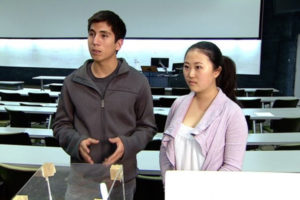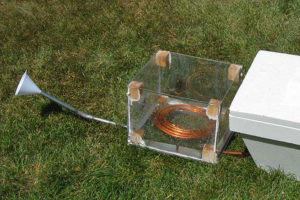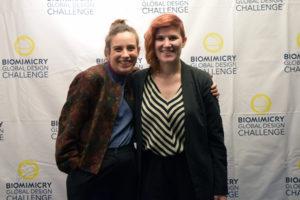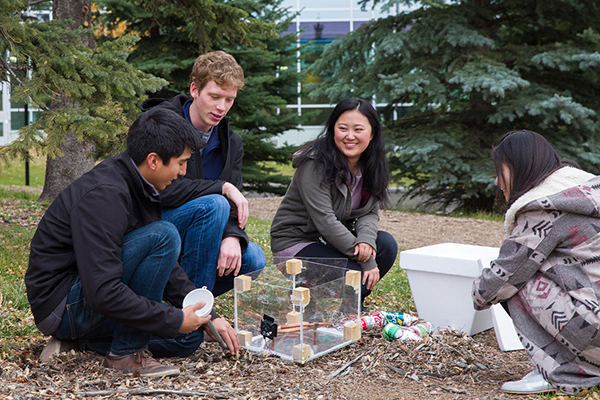Meet alumni from the Biomimicry Global Design Challenge and see how their careers have evolved over the past few years.
Biomimicry has long promised opportunities for hope, because the solutions for our challenges are all around us. In this New Year, many of us have also been anticipating a promise of creating a new ‘normal’, long awaiting the much-needed hugs from loved ones, return to work, travel, health, gatherings with friends and family, and a vaccine, just to name a few. While these distant ideals from the “before” times seem to still be a lifetime away, we remain hopeful for the progress underway with many of the nature-inspired innovations changing the world as we know it.
I’ve been lucky to meet incredible people over the last five years working with the Biomimicry Global Design Challenge (BGDC); and recently I caught up with three Challenge alumni to see what they’ve been up to since their participation in the BGDC and each have integrated concepts of biomimicry and lessons learned into their careers and personal lives. From building a closer relationship to the natural world, to rethinking design, to tapping into a new network, participation in the BGDC goes beyond emulating biological strategies and truly encourages participants to think differently when solving problems. It helps prepare participants to do meaningful work and make an impact in diverse and interdisciplinary fields.
Despite the struggles of the past year, these people are still doing positive work in the world. I hope you are inspired in learning more about their journey and join me in renewing hope and optimism through the promise biomimicry offers.
Meet Jorge Zapote, 2015 BGDC Finalist, 2016 Launchpad, 2016 Ray of Hope Prize 2nd place
 While engineering students at the University of Calgary, Jorge and a team of classmates created WindChill, a concept for a refrigerant-free cooling device that is inspired by how mammals and insects such as coral, termites, kangaroos, bees, elephants, and meerkats regulate temperature. WindChill serves as a cost-effective, modern refrigeration unit designed to be used off the electricity grid to address the problem of food spoiling in impoverished areas without access to electricity.
While engineering students at the University of Calgary, Jorge and a team of classmates created WindChill, a concept for a refrigerant-free cooling device that is inspired by how mammals and insects such as coral, termites, kangaroos, bees, elephants, and meerkats regulate temperature. WindChill serves as a cost-effective, modern refrigeration unit designed to be used off the electricity grid to address the problem of food spoiling in impoverished areas without access to electricity.
After becoming a BGDC finalist in 2015, the WindChill team went on to join the 2016 Launchpad where they learned more about biomimicry and creating an entrepreneurial mindset. They were also the second place winners of the 2016 Ray of Hope Prize, where they allocated a portion of their earnings to registering for a patent and donated another portion into the student club they created at the university called ENOVA. ENOVA is dedicated to biomimicry development, design, and education; and in the years following Jorge and his team’s donation, there have been multiple teams of ENOVA students that have also become finalists in the BGDC.
During our conversation, Jorge reflected on his experience in the BGDC and Launchpad. “The most valuable part of participating in these programs, even more than the prize money, was the leadership and career preparedness I gained,” he said. Jorge recalled standing on the stage at Bioneers, giving his business pitch for WindChill in front of an audience of hundreds of individuals, and talked about how impactful that experience was for him personally and professionally. Jorge has since completed his undergraduate degree in mechanical engineering. After graduation, he began a year-long mechanical engineering internship with Garmin where he was working on designing things like bike pedals and headlights.
Jorge is now finishing up his Master’s degree in mechanical engineering while creating a design consultant business and a smart agriculture startup in aquaponics. Undoubtedly, some of the entrepreneurship training from the Launchpad has helped him move forward with these ventures. He’s found that his curiosity led him to learn more about things he thought he knew, a trait that has been keeping him going in this last year. For example, in starting his design consulting business he’s been teaching himself to code and develop websites.
In 2020, Jorge once again tapped into his biomimicry knowledge and background when he joined back with the BGDC. This time, instead of submitting a winning design, he judged them.
Meet Samuel Serna Wills, 2017 BGDC Finalist, 2018 Launchpad

A product prototype from Coolvita
In 2017, Samuel Serna Wills and his team developed Cooltiva, an active/passive climatization system that takes advantage of wind and sun to maintain temperature indoors. As a changing climate raises temperatures in many regions of the world, including Bogota, Colombia where the Cooltiva team was located, it was becoming increasingly clear that conventional air conditioning systems were only exacerbating the problem. Cooltiva’s nature-inspired solution provide continued thermal comfort using minimal amounts of electrical energy. After being awarded as finalists in the 2017 BGDC, the Cooltiva team went on to join the Launchpad in 2018 to further refine their solution.
Samuel picked up his first physics book as a teenager in 2004, reading the book cover to cover (not even for a class). A few years later, when it came time to decide on what to study at university, physics was a natural choice. Samuel has a unique academic background and has studied physics, mathematics, and classic arts. In hindsight, biomimicry seems like a very natural progression given his inherently interdisciplinary interests.
During COVID, Samuel has been taking time alone to reconnect with nature and spend time outside and build a garden. Reconnection to nature is an essential element of biomimicry, and a critical component of BGDC applications. As Samuel reflects on what may lie ahead, he considers his love of the environment and his appreciation for the natural beauty of his home country, Colombia. His dream job would be to work in ecological restoration; but in the meantime, he’s been working with fellow biomimics and another BGDC alumna that he met during the 2018 Biomimicry Launchpad Bootcamp in San Diego to connect dispersed individuals that are interested in learning and practicing biomimicry in Latin America.
Samuel continues to see the positive impact that biomimicry can have on the world, and he too joined the BGDC again in 2020 to serve as a judge, providing critical feedback to help budding biomimics hone their skills and designs.
Meet Ambra Venturini, 2016 BGDC Finalist, 2017 Launchpad
 In 2016 Ambra and her team devised Share-EET, a meta-project that looks at nature as its mentor, not just in terms of technological innovation but also in terms of social attitudes and cultural paradigm shifts. Ambra and her teammate wanted to shift attitudes about food waste using natural models as inspiration. Share-EET’s events are social experiments where customers share a meal while discussing the implications of their food order. Their (non)restaurant model will only thrive if customers make sustainable choices, demonstrating that personal choices have an impact on the larger community. In 2017, Share-EET was invited to join the Biomimicry Launchpad where they came to San Francisco to refine their ideas and meet fellow biomimicry enthusiasts with goals to implement social change.
In 2016 Ambra and her team devised Share-EET, a meta-project that looks at nature as its mentor, not just in terms of technological innovation but also in terms of social attitudes and cultural paradigm shifts. Ambra and her teammate wanted to shift attitudes about food waste using natural models as inspiration. Share-EET’s events are social experiments where customers share a meal while discussing the implications of their food order. Their (non)restaurant model will only thrive if customers make sustainable choices, demonstrating that personal choices have an impact on the larger community. In 2017, Share-EET was invited to join the Biomimicry Launchpad where they came to San Francisco to refine their ideas and meet fellow biomimicry enthusiasts with goals to implement social change.
Ambra has also used the entrepreneurship training she gained during her participation in the Launchpad to create her own business. Today, Ambra is an intersectional feminist life coach supporting social change-makers looking to disrupt patterns of burn out and build generative boundaries and communities of care. She is also the Communications Officer at Gendered Intelligence, a trans-led charity.
Since participating in the BGDC and Launchpad, Ambra has implemented human-centered design in human rights campaigning projects, collaborated with street artists on international campaigning projects, and put a lot of focus on practicing self and collective care. During the last year, she has found inspiration and motivation through immersing herself in learning how to use tarot as a tool to help create collective spaces for imagination and radical self-acceptance. She also has found it particularly fascinating in connecting her with nature cycles.
However, Ambra’s main focus for the past year has been to slow down and be more in tune with her surroundings—to reconnect.
If you’re interested in furthering your education in biomimicry and coming up with nature-inspired solutions to big, hairy problems, the BGDC is right for you. However, if you’re interested in understanding the relationship between humans and nature, bolstering your own relationship with nature, working toward social change, shifting your perception of what it means to be sustainable, honing personal and professional skills, and growing your network to include diverse change-makers around the world, then the BGDC is definitely right for you.
Over 90% of BGDC participants in 2020 reported a positive impact on development of problem-solving and critical thinking skills, increased creativity, a belief that they can make a difference, and a deeper understanding of sustainability concepts, in addition to an increased understanding of biomimicry and its design process.
The Biomimicry Global Design Challenge has been the starting point for so many passionate individuals to launch into a meaningful future, and you could be the next! What’s stopping you from making your degrees of change?

